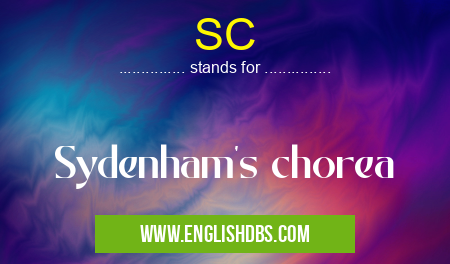What does SC mean in LABORATORY
Sydenham's chorea (SC), also known as St. Vitus' dance, is a neurological disorder that primarily affects children and is characterized by involuntary, purposeless movements. It typically occurs as a complication of untreated streptococcal infections, such as scarlet fever or rheumatic fever.

SC meaning in Laboratory in Medical
SC mostly used in an acronym Laboratory in Category Medical that means Sydenham's chorea
Shorthand: SC,
Full Form: Sydenham's chorea
For more information of "Sydenham's chorea", see the section below.
» Medical » Laboratory
Causes
- SC is caused by the inflammation of the basal ganglia, a brain region involved in controlling movement. This inflammation arises as a reaction to the body's immune response to streptococcal bacteria.
Symptoms
- Involuntary movements: The hallmark of SC is rapid, writhing, involuntary movements that affect various body parts, including limbs, face, trunk, and tongue. These movements are often described as "dance-like."
- Behavioral changes: Children with SC may experience emotional lability, irritability, and difficulty concentrating.
- Speech and swallowing difficulties: The involuntary movements can interfere with speech and swallowing, leading to slurred speech, difficulty eating, and drooling.
Diagnosis
- The diagnosis of SC is based on a physical examination, medical history, and lab tests to confirm a recent streptococcal infection.
Treatment
- The primary treatment for SC is antibiotics to eliminate the underlying streptococcal infection.
- Other treatments may include:
- Anticonvulsants: To suppress involuntary movements
- Behavioral therapy: To manage behavioral symptoms
- Speech and swallowing therapy: To improve communication and swallowing function
Prognosis
- Most cases of SC resolve within a few months. However, some children may experience persistent symptoms or develop other complications, such as rheumatic heart disease.
Essential Questions and Answers on Sydenham's chorea in "MEDICAL»LABORATORY"
What is Sydenham's chorea (SC)?
Sydenham's chorea (SC) is a neurological disorder that develops in children who have had rheumatic fever. It is characterized by involuntary, rapid, purposeless movements of the muscles, particularly in the face, limbs, and trunk.
What causes Sydenham's chorea?
SC is caused by an infection with the bacteria Streptococcus pyogenes (group A streptococcus). The bacteria can cause rheumatic fever, which is a systemic inflammatory disease that can affect the heart, joints, and brain. SC typically develops a few months after an episode of rheumatic fever.
What are the symptoms of Sydenham's chorea?
The symptoms of SC can vary in severity. Some common symptoms include:
- Involuntary, rapid, purposeless movements of the muscles
- Facial grimacing, tongue protrusion, and speech difficulties
- Difficulty with coordination and balance
- Emotional lability and behavioral changes
How is Sydenham's chorea diagnosed?
The diagnosis of SC is based on the patient's symptoms and a physical examination. The doctor may also order blood tests and imaging studies to rule out other conditions.
How is Sydenham's chorea treated?
The treatment for SC focuses on managing the symptoms and preventing complications. Medications such as anticonvulsants and dopamine antagonists may be used to control the involuntary movements. Physical therapy and occupational therapy can help improve coordination and balance.
What is the prognosis for Sydenham's chorea?
The prognosis for SC is variable. In most cases, the symptoms improve within a few months or years. However, some children may experience long-term neurological problems.
Final Words: Sydenham's chorea is a neurological disorder caused by inflammation of the basal ganglia due to streptococcal infections. It manifests in involuntary movements, behavioral changes, and speech or swallowing difficulties. Early diagnosis and treatment with antibiotics are crucial for a favorable prognosis.
SC also stands for: |
|
| All stands for SC |
